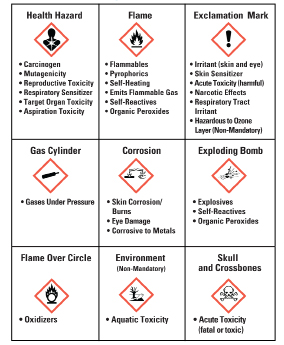Recently, a chemical leak outside a chicken plant in Canton, Georgia, forced the evacuation of 300 employees and four employees were hospitalized.
Nearly 300 employees were evacuated and four people were hospitalized on Sept. 21, 2018, following a chemical spill outside of a Pilgrim's Pride poultry plant in Canton, Ga., according to local news.
Around the world, many countries use the United Nations’ Globally Harmonized System (GHS) to classify and label hazardous chemicals. In the United States, OSHA used this system as the basis for a major rewrite of the Hazard Communication Standards. The old “Right To Know” rules are done; HazCom 2012 gives workers a “Right To Understand.”
As part of the new rules, OSHA’s requirements for the Material Safety Data Sheet (MSDS) have been changed. Now, OSHA expects to see the 16-section Safety Data Sheet (SDS). The shift from MSDS to SDS means replacing those old documents with a clear, consistent format.
Container labels are simpler, too; every chemical label will have the same six parts, from Product Identifiers to Supplier Information. The new labels identify each type of hazard with a bold, recognizable symbol in a red diamond.

The Pilgrim’s Pride accident should remind employers - big and small- about the need for hazardous chemical regulation compliance in the workplace. OSHA considers hazardous chemical compliance and employee understanding as one of the agency’s highest levels of concern in the workplace!!!
OSHA requires that employers implement a written program that meets the requirements of the Hazard Communication Standard (HCS) to provide for worker training, warning labels, and access to Safety Data Sheets (SDSs). Compliance with OSHA’s Hazard Communication Standard ensures employee awareness of the hazardous chemicals they are exposed to in the workplace.
Chemical agents with any of the following characteristics are considered hazardous: carcinogens, corrosives, toxic or highly toxic, irritants, sensitizers, or target organ effectors. See Hazard Communication Standard Appendix A and chemicals listed in 29 CFR 1910.1000 Table 2.
There are exceptions to some of the requirements of the HCS for consumer products that are subjected to the labeling requirements of the terms as defined in the Consumer Product Safety Act and the Federal Hazardous Substances Act [29 CFR 1910.1200(b)(5)(v)].
For example, OSHA does not require that SDSs be provided to purchasers of household consumer products when the products are used in the workplace in the same manner that a consumer would use them i.e., where the duration and frequency of use (and therefore exposure) is not greater than what the typical consumer would experience. For instance, this exemption applies to many of the cleaning products used in nursing homes.
Always remember to:
- Provide readily available (SDSs) for all hazardous chemicals.
- Train workers in potential chemical hazards and controls (engineering controls, work practices, PPE) necessary to prevent hazards in the work area [29 CFR 1910.1200(h)(3)].
- Clearly label as hazardous all hazardous chemicals such as those found in some soaps, disinfectants, and pesticides [29 CFR 1910.1200(f)].
Provide appropriate PPE: (e.g., gloves, goggles, splash aprons) when handling hazardous dishwashing detergents and chemicals [29 CFR 1910.132]. For more information see Healthcare Wide Hazards - (Lack of) Personal Protective Equipment).
Medical Services and First Aid: Where the eyes or body of any person may be exposed to injurious corrosive materials, provide suitable facilities for quick drenching or flushing of the eyes and body within the work area for immediate emergency use [29 CFR 1910.151(c)].
Of course, an employer may choose to use a product that is not considered hazardous.
As an employer, do you have OSHA defined hazardous chemicals employees are potentially exposed to in the workplace? If so, are you maintaining the requisite OSHA hazardous chemical program for employee safety and awareness? Contact an attorney at our Sioux Falls, Sioux City, or Omaha office for assistance.






Let Us Know What You Thought about this Post.
Put your Comment Below.